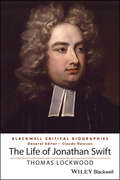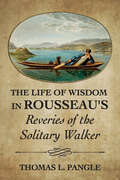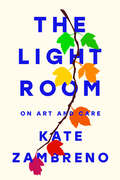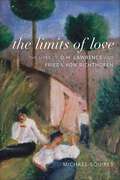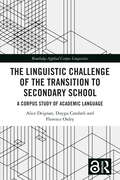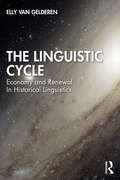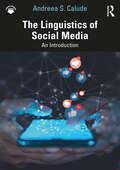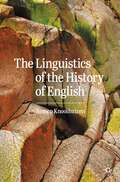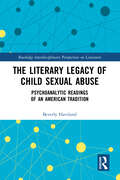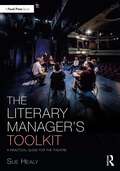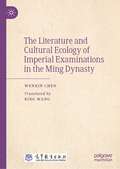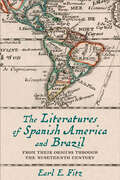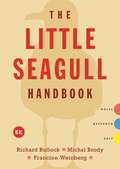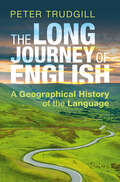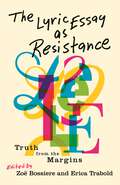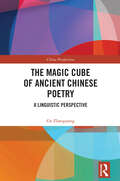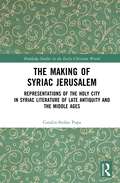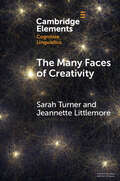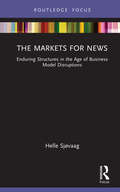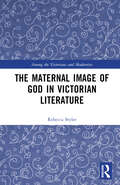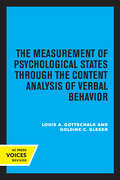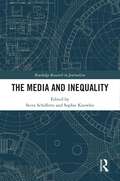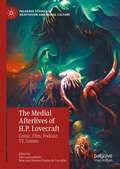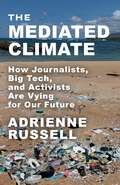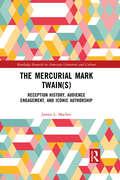- Table View
- List View
The Life of Jonathan Swift (Wiley Blackwell Critical Biographies)
by Thomas LockwoodPresents a fresh account of the life history and creative imagination of Jonathan Swift Classic satires such as Gulliver’s Travels, A Modest Proposal, and A Tale of a Tub express radical positions, yet were written by the most conservative of men. Jonathan Swift was born in Dublin and spent most of his life in Ireland, never traveling outside the British Isles. An Anglo-Irish Protestant clergyman, he was a major political and religious figure whose career was primarily clerical, not literary. Although much is known about Swift, in many ways he remains an enigma. He was admired as an Irish patriot yet was contemptuous of the Irish. He was both secretive and self-dramatizing. His talent for friendship was matched by his skill for making enemies. He hated the English but yearned to live in England. The Life of Jonathan Swift explores the writing life and personal history of the foremost satirist in the English language. Accessible and engaging, this critical biography brings Swift’s writing and creative sensibility into the narrative of his life. Author Thomas Lockwood provides the historical and modern critical context of Swift’s prose satires and poetry, as well as his political journalism, essays, manuscripts, and personal correspondence. Throughout the book, biographically contextualized descriptions of Swift’s most famous works help readers better understand both the writing and the writer. Provides critical profiles of Gulliver’s Travels, An Argument Against Abolishing Christianity, Drapier’s Letters, and Swift’s other famous works Offers insights into Swift’s relationships with Esther Johnson, “Stella,” and Esther Vanhomrigh, “Vanessa” Highlights Swift’s poetry and how verse writing was a vital part of his creative being Summarizes and contextualizes lesser-known works such as The Conduct of the Allies Addresses the historic critical bias against comedy or satire as inferior forms of art, both in Swift’s lifetime and the presentThe Life of Jonathan Swift is an essential resource for general readers of literature and literary biography, university instructors and researchers, and undergraduate students taking courses in English literature.
The Life of Wisdom in Rousseau's "Reveries of the Solitary Walker"
by Thomas L. PangleThe Life of Wisdom in Rousseau's "Reveries of the Solitary Walker" is the first complete exegesis and interpretation of Rousseau's final and culminating work, showing its full philosophic and moral teaching. The Reveries has been celebrated as a work of literature that is an acknowledged acme of French prose writing. Thomas L. Pangle argues that this aesthetic appreciation necessitates an in-depth interpretation of the writing's complex and multileveled intended teaching about the normatively best way of life—and how essential this is for a work that was initially bewildering.Rousseau stands out among modern political philosophers in that he restored, to political philosophy, what Socrates and his students (from Plato and Xenophon through Aristotle and the Stoics and Cicero) had made central—and that the previous modern, Enlightenment philosophers had eclipsed: the study of the life and soul of the exemplary, independent sage, as possessor of "human wisdom." Rousseau made this again the supreme theme and source of norms for political philosophy and for humanity's moral as well as civic existence.In his analysis of The Reveries, Pangle uncovers Rousseau's most profound exploration and articulation of his own life, personality, soul, and thought as "the man of nature enlightened by reason." He describes, in Rousseau's final work, the fullest embodiment of the experiential wisdom from which flows and to which points Rousseau's political and moral philosophy, his theology, and his musical and literary art.
The Light Room
by Kate Zambreno&“Kate Zambreno has invented a new form. It is a kind of absolute present, real life captured in closeup.&“ —Annie Ernaux, winner of the Nobel Prize in Literature From &“one of our most formally ambitious writers&” (Esquire), a moving account of caretaking in a time of uncertainty and lossIn The Light Room, Zambreno offers her most profound and affecting work yet: a candid chronicle of life as a mother of two young daughters in a moment of profound uncertainty about public health, climate change, and the future we can expect for our children. Moving through the seasons, returning often to parks and green spaces, Zambreno captures the isolation and exhaustion of being home with a baby and a small child, but also small and transcendent moments of beauty and joy. Inspired by writers and artists ranging from Natalia Ginzburg to Joseph Cornell, Yūko Tsushima to Bernadette Mayer, Etel Adnan to David Wojnarowicz, The Light Room represents an impassioned appreciation of community and the commons, and an ecstatic engagement with the living world.How will our memories, and our children&’s, be affected by this time of profound disconnection? What does it mean to bring new life, and new work, into this moment of precarity and crisis? In The Light Room, Kate Zambreno offers a vision of how to live in ways that move away from disenchantment, and toward light and possibility.
The Limits of Love: The Lives of D. H. Lawrence and Frieda von Richthofen
by Michael SquiresThe Limits of Love: The Lives of D. H. Lawrence and Frieda von Richthofen provides a candid look at two illustrious people who tested the capacity—and the limits—of marriage. The Lawrences come alive not as simple quarreling travelers, nor as blissful domestic partners, but as complex personalities who experimented with marriage to see if it would fulfill their needs. Their antagonisms and their sexual experiences informed Lawrence’s fearless novels The Rainbow and Women in Love. Both works also tested the boundaries of public taste and faced harsh receptions.The cost of the Lawrences’ strong but unstable marriage was high. Despite periods of happiness and peace, angry clashes meant separations and uneasy agreements to repair the marital intimacy when it cracked. Fractures of 1916, 1919, 1923, and 1926 healed slowly and with difficulty. In Lawrence’s most calculated and famous work, Lady Chatterley’s Lover, he successfully coded their marital stress and, full of rage, fused two stories of failed marriages.Drawing on many unpublished and recently discovered letters, The Limits of Love offers readers a detailed reconstruction of two complicated lives, written with narrative speed and a forceful style, filled with vivid interpretations of Lawrence’s work, and conveying deep sympathy for people living outside established norms. This new dual biography, based on years of research by Michael Squires, captures the essence of Lawrence and Frieda, making the couple real, alive, and accessible.
The Linguistic Challenge of the Transition to Secondary School: A Corpus Study of Academic Language (Routledge Applied Corpus Linguistics)
by Alice Deignan Duygu Candarli Florence OxleyThis book provides a unique analysis and description of the linguistic challenges faced by school students as they move from primary to secondary school, a major transition, which some students struggle with emotionally and academically. The study: • draws on a bespoke corpus of 2.5 million words of written materials and transcribed classroom recordings, provided by the project's partner schools; • combines quantitative and qualitative approaches to the corpus data to explore linguistic variation across school levels, registers and subjects; • describes the procedures of corpus compilation and analysis of written and spoken academic language, showing how modern corpus tools can be applied to this far-reaching social and educational issue; • uncovers differences and similarities between the academic language that school children are exposed to at primary and secondary school, contrasting this against the backdrop of the non-academic language that they encounter outside school. This book is important reading for advanced students and researchers in corpus linguistics, applied linguistics and teacher education. It carries implications for policymakers and schools looking to support students at this critical point in their schooling.
The Linguistic Cycle: Economy and Renewal in Historical Linguistics
by Elly van GelderenCyclical language change is a linguistic process by which a word, phrase, or part of the grammar loses its meaning or function and is then replaced by another. This can even happen on the level of an entire language, which can experience a change in the language family it is a part of. This new text is a comprehensive introduction to this phenomenon, the mechanisms underlying it, and the relations between the different types of cycles. Elly van Gelderen reviews the subject widely and holistically, defining key terms and comprehensively presenting diverse theoretical perspectives and empirical findings. With coverage of a variety of micro cycles and the more controversial macro cycles, incorporating cutting-edge work on grammaticalization, and drawing on examples from many languages and language families, this book accessibly guides readers through the state of the art in the field. With practical methodological guidance on how to identify and investigate linguistic cycles, and an array of useful pedagogical features, the book provides a coherent framework for approaching, understanding, and furthering research in linguistic cycles. This text will be an indispensable resource for advanced students and researchers in historical and diachronic linguistics, language typology, and linguistic and grammatical theory.
The Linguistics of Social Media: An Introduction
by Andreea S. CaludeThis accessible textbook introduces concepts and frameworks from linguistics and uses them in the analysis of language on social media. Assuming no prior knowledge of linguistics and with examples drawn from 12 different social media platforms, including TikTok, Twitter (the book was written prior to the X rebrand), Instagram, Facebook and Snapchat, The Linguistics of Social Media: An Introduction provides the tools to unpick how language is used to portray a particular identity, to persuade, to inform, to amuse and entertain, to vent and to complain. Analysing the language of social media highlights the strategies which operate in the messages and posts found on such platforms. Together, these strategies involve a wide variety of language registers, creativity and language play and a wealth of linguistic innovation. By evidencing the many nuanced ways in which people are engaging with social media, this book demonstrates how users of social media are linguistically savvy, strategic and skilled in navigating different genres and registers online. The book is divided into ten chapters, each comprising two parts: Part 1 introduces key linguistic theory and Part 2 consists of case studies with examples from different social media platforms to demonstrate a particular discourse purpose. Each chapter ends with a summary, references, suggested further readings and ideas for activities and discussions. There are multiple-choice questions and a glossary available online as support material. This is the essential textbook for all courses on language and social media, linguistics and language and communication courses.
The Linguistics of the History of English
by Remco KnooihuizenThis textbook approaches the history of English from a theoretical perspective. The book provides a brief chronological overview describing the way in which the English language has changed over time from Old English to Modern English, while subsequent parts adopt a theoretical focus that is thematically organised to deal with the question of how and why English changed in the way it did, including a part addressing some specific contact-induced changes and key topics such as English as a Lingua Franca. Supported throughout with information boxes with empirical studies, the examples given are all drawn from English, but boxes with examples from other languages tie the development of the English language into changes in other contexts and settings. This book is an ideal resource for undergraduate students of the English Language and historical linguistics.
The Literary Legacy of Child Sexual Abuse: Psychoanalytic Readings of an American Tradition (Routledge Interdisciplinary Perspectives on Literature)
by Beverly HavilandThis book examines the representation of child sexual abuse in five American novels written from 1850 to the present. The historical range of the novels shows that child sexual abuse is not a new problem, although it has been called by other names in other eras. The introduction explains what literature and literary criticism bring to persistent questions that arise when children are sexually abused. Psychoanalytic concepts developed by Freud, Ferenczi, Kohut, and Lacan inform readings of the novels. Theories of trauma, shame, psychosis, and perversion provide insights into the characters represented in the stories. Each chapter is guided by a difficult question that has arisen from real-life situations of child sexual abuse. Legal and therapeutic interventions respond with their disciplinary resources to these questions as they concern victims, perpetrators, and witnesses. Literary criticism offers another analytic framework that can significantly inform those responses.
The Literary Manager's Toolkit: A Practical Guide for the Theatre (The Focal Press Toolkit Series)
by Sue HealyThe Literary Manager’s Toolkit is a clear and comprehensive guide to the role of the literary manager in theatre and beyond, focusing on the key skills, networks, and processes that underpin a successful career in this and associated roles. This book outlines the tasks and responsibilities of a literary manager in the selection, development, and production of new plays. In the first part, it outlines the how, when, and why of the literary manager’s main activities, equipping the reader with everything that they will need when approaching this role’s central challenges. The second part provides a selection of practical, accessible, and easy-to-follow materials and workshop suggestions for literary managers who will work with playwrights as they develop their creative writing and dramaturgy skills. This is the go-to resource for the working professional literary manager or dramaturg, and for students on dramaturgy courses in theatre degree programmes.
The Literature and Cultural Ecology of Imperial Examinations in the Ming Dynasty
by Wenxin ChenThe book examines the relationship between imperial examinations and literature from the perspective of restoring the cultural ecology of imperial examinations in Ming China, breaking through the paradigm of pure literature research. This book presents an important practice in adjusting the pattern of literary research. The contents of this book include five mutually independent but supportive parts: 1) the living conditions and careers of the literary attendants; 2) the educational background and school’s consciousness of the Ming literati; 3) top candidates and Ming literature; 4) genres of imperial examination and the Ming society; 5) exam cheating cases from the perspective of politics and literature. This book will appeal to readers interested in Chinese literature and culture and the imperial examination system in ancient China.
The Literatures of Spanish America and Brazil: From Their Origins through the Nineteenth Century (New World Studies)
by Earl E. FitzIn this survey of Central and South American literature, Earl E. Fitz provides the first book in English to analyze the Portuguese- and Spanish-language American canons in conjunction, uncovering valuable insights about both. Fitz works by comparisons and contrasts: the political and cultural situation at the end of the fifteenth century in Spain and Portugal; the indigenous American cultures encountered by the Spanish and Portuguese and their legacy of influence; the documented discoveries of Colón and Caminha; the colonial poetry of Mexico’s Sor Juana Inés de la Cruz and Brazil’s Gregório de Matos; culminating in a meticulous evaluation of the poetry of Nicaragua’s Rubén Darío and the prose fiction of Brazil’s Machado de Assis. Fitz, an award-winning scholar of comparative literature, contends that at the end of the nineteenth century, Latin America produced two great literary revolutions, both unique in the western hemisphere, and best understood together.
The Little Seagull Handbook (Fifth Edition)
by Richard Bullock Francine Weinberg Michal BrodyWrite. Research. Edit. Everything students need in an affordable handbook they truly use. The Little Seagull Handbook is the #1 best-selling handbook because it’s easy to use, easy to afford, and covers everything students need—no more, no less. Intuitive organization, color coding, and jargon-free instruction for common kinds of writing make it a reference tool that student writers truly rely on. This edition includes new advice designed for developing writers, new advice for using inclusive language, and two new complete model student essays using MLA and APA documentation. This purchase offers access to the digital ebook only.
The Long Journey of English: A Geographical History of the Language
by Peter TrudgillEnglish is one of the most widely-spoken languages in the world, with native-speaking communities at the furthest ends of the earth. However, just three thousand years ago, the language-which-became-English was not spoken anywhere in Britain. Trudgill, one of the foremost authorities on the English language, takes us on a remarkable journey through the history of English to show how it grew to become the global phenomenon that we know today. Over ten short, easily digestible chapters, he traces its development and global spread, starting with the earliest genesis of English five thousand years ago, exploring its expansion in the British Isles, and finishing with an overview of how the language looks today, including its use in an increasingly digital world. Particular attention is paid to the native-speaker varieties of English from all around the world, and the relationship between colonial varieties of English and indigenous languages.
The Lyric Essay as Resistance: Truth from the Margins
by Chloe Garcia Roberts Melissa Febos Jenny Boully Molly McCully Brown Michael Torres Wendy Walters Torrey Peters Danielle Geller Elissa Washuta Krys Malcolm Belc Chelsea Biondolillo Crystal Wilkinson Jessica Lind Peterson Lyzette Wanzer Aisha Sabatini Sloan Camellia-Berry Grass Hea-Ream Lee Jennifer S. Cheng Lillian-Yvonne Bertram Thirii Myo MyintLyric essayists draw on memoir, poetry, and prose to push against the arbitrary genre restrictions in creative nonfiction, opening up space not only for new forms of writing, but also new voices and a new literary canon. This anthology features some of the best lyric essays published in the last several years by prominent and emerging writers. Editors Zoë Bossiere and Erica Trabold situate this anthology within the ongoing work of resistance—to genre convention, literary tradition, and the confines of dominant-culture spaces. As sites of resistance, these essays are diverse and include investigations into deeply personal and political topics such as queer and trans identity, the American BIPOC experience, reproductive justice, belonging, grief, and more. The lyric essay is always surprising; it is bold, unbound, and free. This collection highlights the lyric essay’s natural capacity for representation and resistance and celebrates the form as a subversive genre that offers a mode of expression for marginalized voices. The Lyric Essay as Resistance features contemporary work by essayists including Melissa Febos, Wendy S. Walters, Torrey Peters, Jenny Boully, Crystal Wilkinson, Elissa Washuta, Lillian-Yvonne Bertram, and many more. Their work demonstrates the power of the lyric essay to bring about change, both on the page and in our communities.
The Magic Cube of Ancient Chinese Poetry: A Linguistic Perspective (China Perspectives)
by Ge ZhaoguangThis book focuses on the linguistic perspective of classical Chinese poetry and its changes and development in diff erent historical periods. It off ers a combination of theoretical analysis and aesthetic appreciation of exemplary poems. The author discusses the following aspects of classical Chinese poetry: the relationships between background and meaning in the interpretation of a poem; how readers can deal with the tangle of linguistic approach and intuitive perception in interpreting poems; the engagement and disengagement of the poet’s thought fl ow with and from the word order of the verse; the tonal and metrical schemes; and the three special features of classical Chinese poetry: the signifi cance and role of allusions, “Xu Zi”, and “Shi Yan”. Last, the author analyses the development of Chinese poetry from the Vernacular Song Dynasty Style to the Vernacular Modern Style. It will be a great read for students and scholars of East Asian studies, Chinese studies, linguistics, and those interested in Chinese poetry in general. The book aims to lead readers to discover a fresh and amazing world of classical Chinese poetry, a fantastic panoramic picture of its beauty and charm, and a poetic feast that the reader may not otherwise be privileged to enjoy.
The Making of Syriac Jerusalem: Representations of the Holy City in Syriac Literature of Late Antiquity and the Middle Ages (Routledge Studies in the Early Christian World)
by Catalin-Stefan PopaThis book discusses hagiographic, historiographical, hymnological, and theological sources that contributed to the formation of the sacred picture of the physical as well as metaphysical Jerusalem in the literature of two Eastern Christian denominations, East and West Syrians. Popa analyses the question of Syrian beliefs about the Holy City, their interaction with holy places, and how they travelled in the Holy Land. He also explores how they imagined and reflected the theology of this itinerary through literature in Late Antiquity and the Middle Ages, set alongside a well-defined local tradition that was at times at odds with Jerusalem. Even though the image of Jerusalem as a land of sacred spaces is unanimously accepted in the history of Christianity, there were also various competing positions and attitudes. This often promoted the attempt at mitigating and replacing Jerusalem’s sacred centrality to the Christian experience with local sacred heritage, which is also explored in this study. Popa argues that despite this rhetoric of artificial boundaries, the general picture epitomises a fluid and animated intersection of Syriac Christians with the Holy City especially in the medieval era and the subsequent period, through a standardised process of pilgrimage, well-integrated in the custom of advanced Christian life and monastic canon. The Making of Syriac Jerusalem is suitable for students and scholars working on the history, literature, and theology of Syriac Christianity in the late antique and medieval periods.
The Many Faces of Creativity: Exploring Synaesthesia through a Metaphorical Lens (Elements in Cognitive Linguistics)
by Jeannette Littlemore Sarah TurnerCreative metaphor has been of central interest to the cognitive linguistic research community in recent years. However, little is known about what propels people to use metaphor in a creative way. In this Element, the authors identify and explore some of the clues that synaesthesia may provide to help us better understand the factors that drive creativity, with a particular focus on creative metaphor. They identify the factors that seem to trigger the production of creative metaphor in synaesthetes, and explore what this can tell us about creativity in the population more generally. Their findings provide insights into the nature of creativity as it relates to metaphor, emotion and embodied experience. They argue that the production of creative metaphor arises from strong affective reactions to sensory and emotional stimuli and that there is an embodied symbiotic relationship between sensory experiences, embodiment, emotion, hyperbole, empathy, metaphor and creativity.
The Markets for News: Enduring Structures in the Age of Business Model Disruptions (Disruptions)
by Helle SjøvaagIn the face of ongoing digitisation, The Markets for News examines how certain established economic features of the news industry have persisted and what makes them such stable frameworks for journalistic organisations. Drawing on an analysis of Scandinavian news industries, this text revises journalism’s economic foundations in the context of the algorithmically driven platform economy. Exploration of features such as journalism’s two-sided market model, the network effect of platforms, and chain ownership, leads to a discussion about how journalism faces disruption from the introduction of artificial intelligence in the production, dissemination, and sale of news. As journalism undergoes transformations due to revenue losses, this book recognises a return to certain enduring features of journalism’s organisational form, in particular the chain ownership form, that enables scale in adapting to platform logics and economics. This text serves as a basis for a theoretical discussion about strategic media management and critical political economy in the age of digital disruption. This is an insightful book for academics and researchers in the fields of journalism, media industries, media policy and, communication studies.
The Maternal Image of God in Victorian Literature (Among the Victorians and Modernists)
by Rebecca StylerThis book is the study of a religious metaphor: the idea of God as a mother, in British and US literature 1850–1915. It uncovers a tradition of writers for whom divine motherhood embodied ideals felt to be missing from the orthodox masculine deity. Elizabeth Gaskell, Josephine Butler, George Macdonald, Frances Hodgson Burnett and Charlotte Perkins Gilman independently reworked their inherited faith to create a new symbol that better met their religious needs, based on ideal Victorian notions of motherhood and ‘Mother Nature’. Divine motherhood signified compassion, universal salvation and a realised gospel of social reform led primarily by women to establish sympathetic community. Connected to Victorian feminism, it gave authority to women’s voices and to ‘feminine’ cultural values in the public sphere. It represented divine immanence within the world, often providing the grounds for an ecological ethic, including human–animal fellowship. With reference also to writers including Charlotte Brontë, Anna Jameson, Charles Kingsley, Elizabeth Charles, Theodore Parker, Harriet Beecher Stowe, Mary Baker Eddy and authors of literary utopias, this book shows the extent of maternal theology in Victorian thought and explores its cultural roots. The book reveals a new way in which Victorian writers creatively negotiated between religious tradition and modernity.
The Measurement of Psychological States Through the Content Analysis of Verbal Behavior
by Louis A. Gottschalk Goldine C. GleserThis title is part of UC Press's Voices Revived program, which commemorates University of California Press’s mission to seek out and cultivate the brightest minds and give them voice, reach, and impact. Drawing on a backlist dating to 1893, Voices Revived makes high-quality, peer-reviewed scholarship accessible once again using print-on-demand technology. This title was originally published in 1969.
The Media and Inequality (Routledge Research in Journalism)
by Steve Schifferes Sophie KnowlesThis book brings together a vast range of pre-eminent experts, academics, and practitioners to interrogate the role of media in representing economic inequality. It explores and deconstructs the concept of economic inequality by examining the different dimensions of inequality and how it has evolved historically; how it has been represented and portrayed in the media; and how, in turn, those representations have informed the public’s knowledge of and attitudes towards poverty, class and welfare, and political discourse. Taking a multi-disciplinary, comparative, and historical approach, and using a variety of new and original data sets to inform the research, studies herein examine the relationship between media and inequality in UK, Western Europe, and USA. In addition to generating new knowledge and research agendas, the book generates suggestions of ways to improve news coverage on this topic and raise the level of the debate, and will improve understanding about economic inequality, as it has evolved, and as it continues to develop in academic, political and media discourses. This book will be of interest to academics and practitioners alike in the areas of journalism, media studies, economics, and the social sciences, as well as political commentators and those interested more broadly in social policy.
The Medial Afterlives of H.P. Lovecraft: Comic, Film, Podcast, TV, Games (Palgrave Studies in Adaptation and Visual Culture)
by Tim Lanzendörfer Max José Dreysse Passos de CarvalhoMedial Afterlives of H.P. Lovecraft brings together essays on the theory and practice of adapting H.P. Lovecraft’s fiction and the Lovecraftian. It draws on recent adaptation theory as well as broader discourses around media affordances to give an overview over the presence of Lovecraft in contemporary media as well as the importance of contemporary media in shaping what we take Lovecraft’s legacy to be. Discussing a wide array of medial forms, from film and TV to comics, podcasts, and video and board games, and bringing together an international group of scholars, the volume analyzes individual instances of adaptation as well as the larger concern of what it is possible to learn about adaptation from the example of H.P. Lovecraft, and how we construct Lovecraft and the Lovecraftian today in adaptation. Medial Afterlives of H.P. Lovecraft is focused on an academic audience, but it will nonetheless hold interest for all readers interested in Lovecraft today.
The Mediated Climate: How Journalists, Big Tech, and Activists Are Vying for Our Future
by Adrienne RussellTo what extent does journalism deserve blame for the failure to address climate change over the last thirty years? Critics point out that climate coverage has often lacked necessary urgency and hewed to traditional notions of objectivity and balance that allowed powerful interests—mainly fossil fuel companies—to manufacture doubt. Climate journalism, however, developed alongside the digital media landscape, which is characterized by rampant misinformation, political polarization, unaccountable tech companies, unchecked corporate power, and vast inequalities. Under these circumstances, journalism struggled, and bad actors flourished, muddling messages while emissions mounted and societies struggled to avert catastrophe.The Mediated Climate explores the places where the climate and information crises meet, examining how journalism, activism, corporations, and Big Tech compete to influence the public. Adrienne Russell argues that the inadequate response to climate change is intertwined with the profound challenges facing the communications environment. She demonstrates that the information crisis is driven not only by technological changes but also by concentrated power that predates the rise of digital media companies. Efforts to improve climate coverage must take into account the larger social and material contexts in which journalism operates and the broader power dynamics that shape public discourse. Drawing on interviews with journalists and activists, Russell considers the ways recent movements are battling misinformation. She offers timely recommendations to foster engagement with climate issues and calls on readers to join in efforts to reshape the media landscape to better serve the public interest.
The Mercurial Mark Twain: Reception History and Iconic Authorship (Routledge Research in American Literature and Culture)
by James L. MachorWho was Mark Twain? Was he the genial author of two beloved boys books, the white-haired and white-suited avuncular humorist, the realistic novelist, the exposer of shams, the author repressed by bourgeois values, or the social satirist whose later writings embody an increasingly dark view? In light of those and other conceptions, the question we need to ask is not who he was but how did we get so many Mark Twains? The Mercurial Mark Twains(s): Reception History and Iconic Authorship provides answers to that question by examining the way Twain, his texts, and his image have been constructed by his audiences. Drawing on archival records of responses from common readers, reviewer reactions, analyses by Twain scholars and critics, and film and television adaptations, this study provides the first wide-ranging, fine-grained historical analysis of Twain’s reception in both the public and private spheres, from the 1860s until the end of the twentieth century.
